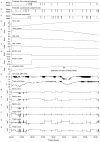A Machine Learning Model for Predicting Sleep and Wakefulness Based on Accelerometry, Skin Temperature and Contextual Information
- PMID: 38863481
- PMCID: PMC11164689
- DOI: 10.2147/NSS.S452799
A Machine Learning Model for Predicting Sleep and Wakefulness Based on Accelerometry, Skin Temperature and Contextual Information
Abstract
Purpose: Body-worn accelerometers are commonly used to estimate sleep duration in population-based studies. However, since accelerometry-based sleep/wake-scoring relies on detecting body movements, the prediction of sleep duration remains a challenge. The aim was to develop and evaluate the performance of a machine learning (ML) model to predict accelerometry-based sleep duration and to explore if this prediction can be improved by adding skin temperature data, circadian rhythm based on the estimated midpoint of sleep, and cyclic time features to the model.
Patients and methods: Twenty-nine adults (17 females), mean (SD) age 40.2 (15.0) years (range 17-70) participated in the study. Overnight polysomnography (PSG) was recorded in a sleep laboratory or at home along with body movement by two accelerometers with an embedded skin temperature sensor (AX3, Axivity, UK) positioned at the low back and thigh. The PSG scoring of sleep/wake was used as ground truth for training the ML model.
Results: Based on pure accelerometer data input to the ML model, the specificity and sensitivity for predicting sleep/wake was 0.52 (SD 0.24) and 0.95 (SD 0.03), respectively. Adding skin temperature data and contextual information to the ML model improved the specificity to 0.72 (SD 0.20), while sensitivity remained unchanged at 0.95 (SD 0.05). Correspondingly, sleep overestimation was reduced from 54 min (228 min, limits of agreement range [LoAR]) to 19 min (154 min LoAR).
Conclusion: An ML model can predict sleep/wake periods with excellent sensitivity and moderate specificity based on a dual-accelerometer set-up when adding skin temperature data and contextual information to the model.
Keywords: actigraphy; epidemiology; sedentary behaviors; sleep quality; supervised machine learning; support vector machines.
© 2024 Logacjov et al.
Conflict of interest statement
The authors report no conflicts of interest in this work.
Figures




Similar articles
-
Development and performance of a sleep estimation algorithm using a single accelerometer placed on the thigh: an evaluation against polysomnography.J Sleep Res. 2023 Apr;32(2):e13725. doi: 10.1111/jsr.13725. Epub 2022 Sep 27. J Sleep Res. 2023. PMID: 36167935 Free PMC article.
-
Validation of an automated sleep detection algorithm using data from multiple accelerometer brands.J Sleep Res. 2023 Jun;32(3):e13760. doi: 10.1111/jsr.13760. Epub 2022 Oct 31. J Sleep Res. 2023. PMID: 36317222
-
A novel machine learning unsupervised algorithm for sleep/wake identification using actigraphy.Chronobiol Int. 2020 Jul;37(7):1002-1015. doi: 10.1080/07420528.2020.1754848. Epub 2020 Apr 28. Chronobiol Int. 2020. PMID: 32342702
-
Validation of actigraphy sleep metrics in children aged 8 to 16 years: considerations for device type, placement and algorithms.Int J Behav Nutr Phys Act. 2024 Apr 16;21(1):40. doi: 10.1186/s12966-024-01590-x. Int J Behav Nutr Phys Act. 2024. PMID: 38627708 Free PMC article.
-
Challenges and Emerging Technologies within the Field of Pediatric Actigraphy.Front Psychiatry. 2014 Aug 21;5:99. doi: 10.3389/fpsyt.2014.00099. eCollection 2014. Front Psychiatry. 2014. PMID: 25191278 Free PMC article. Review.
Cited by
-
Movement Behaviors in Youth on the Autism Spectrum: The HUNT Study, Norway.J Autism Dev Disord. 2025 Apr 21. doi: 10.1007/s10803-025-06835-7. Online ahead of print. J Autism Dev Disord. 2025. PMID: 40257659
References
LinkOut - more resources
Full Text Sources

